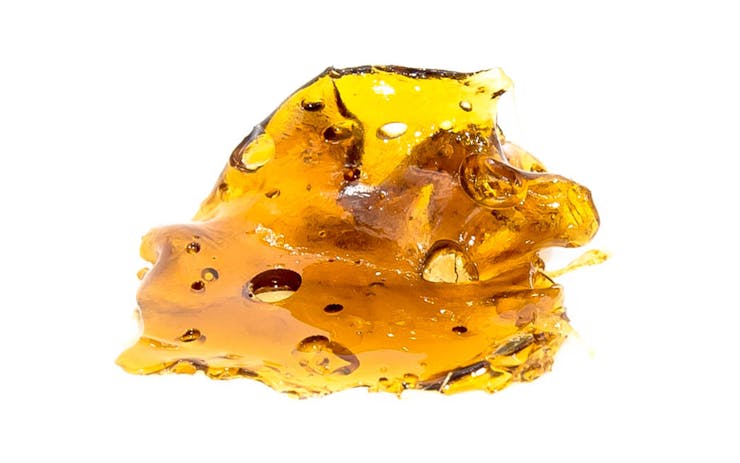Shatter is a cannabis extract that is solid and translucent in appearance, as if you could shatter it like glass. It achieves its glass-like appearance through specific processing techniques involving solvents like butane or other hydrocarbons. Concentrating essential compounds like THC and CBD, shatter offers the benefits of cannabis in a highly concentrated, compact form that is popularly dabbed or vaporized.
“That Tangie shatter I dabbed tastes like pure oranges.”
“I like shatter, but wax is easier to scoop out of the container.”
What is shatter?
Shatter is a cannabis concentrate that is named for its hard, glass-like consistency that tends to crack, or shatter, when broken apart. It is typically gold or amber in color. Although shatter is popularly believed to be more potent or pure than other types of extracts, this is not always true; its appearance instead has only to do with the extract’s molecules being less agitated during production.
Shatter is usually dabbed, a method of consumption that involves flash vaporization off of a specialized water pipe called a dab rig. This glassy extract has a reputation for being potent, though it can range in potency depending on the chemical composition of the source plant and the extraction techniques and equipment used. While the high watermark for cannabis flower tends to sit around 30% THC, shatter extracts may test upward of 80% to 90% THC.
How is shatter made?
Shatter can be made using a variety of production methods, but it is typically created using butane or hydrocarbon solvents. Butane extracts are also called BHO, short for “butane hash oil.” To make BHO, cannabis is typically contained in a tube where butane or other hydrocarbons are pushed through the plant material, stripping away desirable compounds like THC and CBD. The concentrated oil is collected and may be further refined using additional techniques. “Purging,” for example, refers to the removal of excess residual solvents using a vacuum chamber, and “winterization” refers to the separation of fats and lipids from the oil.
Shatter and other types of BHO are extremely dangerous to make using at-home DIY setups due to the flammability of butane fumes. Attempts to make BHO in home environments have resulted in several accidental explosions. Professional-grade shatter is produced using safe closed-loop systems that prevent these fumes from entering the ambient environment.
Difference between shatter and wax
Shatter refers to cannabis extracts that take on a hard, glassy form while waxes are softer and more malleable. The difference between shatter and wax is primarily a superficial one: it’s merely a cosmetic difference caused by a difference in molecular agitation. Shatter maintains its glass-like consistency because the molecules in the extract were left undisturbed during processing, whereas the molecules in wax were agitated.
The level of transparency achieved in the production process does not reflect the potency of the extract. In other words, shatter is not necessarily higher in THC than wax, and vice versa. To determine the potency and chemical composition of any given extract, refer to the lab results of individual products at your local dispensary.
One practical difference between shatter and wax has to do with ease of use. Wax is softer and sometimes easier to handle using dabbing tools like scoops. Because shatter tends to crack apart into unpredictably sized pieces when broken, you may find that it’s a little harder to scoop and dose the correct sized dab.
